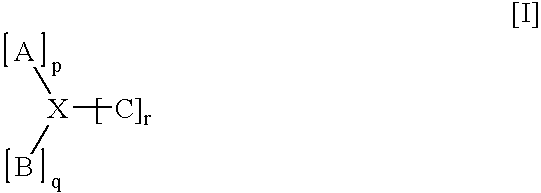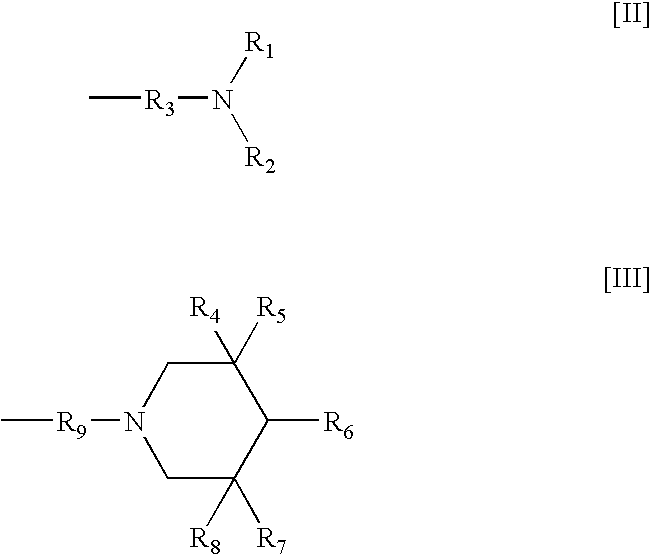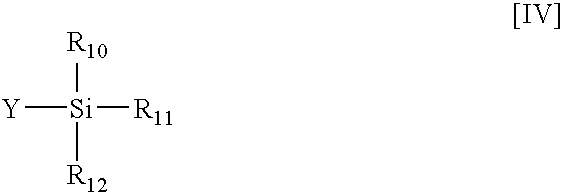Curable coating composition
a coating composition and coating technology, applied in coatings, special tyres, transportation and packaging, etc., can solve the problems of electric corrosion of the coated material, the change of the material itself, and the need for more complicated properties and functions of the material, so as to improve the resistance of the coating film against water, chemicals and so on, and improve the resistance of the coating film. , good impact resistance and flexibility
- Summary
- Abstract
- Description
- Claims
- Application Information
AI Technical Summary
Benefits of technology
Problems solved by technology
Method used
Image
Examples
example 1
[0111] In a 2L four-inlet flask equipped with a stirrer, a thermometer and a nitrogen gas inlet was charged 393.2 g of xylene (XYL) / propylene glycol monomethyl ether (PM) (=70 / 30), and heated to 90.degree. C. To a 1L beaker were charged 500 g of methyl methacrylate (MMA) / n-butyl methacrylate (BMA) / n-butyl acrylate (BA) / glycidyl methacrylate (GMA) / 2-hydroxyethyl methacrylate (HEMA) (=32 / 20 / 20 / 20 / 8), 1 g of n-dodecyl mercaptane (DM) and 5 g of .alpha.,.alpha.-azobisisobutyronitri-le (AIBN). The mixture was stirred until a homogenous mixture was produced, thereby a monomer mixture was prepared. The monomer mixture was added dropwise to the flask over 4 hours using a dropping pump (a constant delivery pump). After the dropwise addition was completed, the polymerization reaction was continued for 1 hour. A mixed slurry of XYL (100 g) and AIBN (0.8 g) was added to the reaction solution dividedly by three portions at 1-hour intervals. Thereafter, the polymerization was continued for additi...
example 2
[0114] In a 2L four-inlet flask equipped with a stirrer, a thermometer and a nitrogen gas inlet were charged 370 g of toluene (TOL) / .gamma.-butyrolactone (=70 / 30) and 44.5 g of "ARON Macromer AA-6" (methyl methcrylate macromer, 45% solution in toluene; Toagosei Co., Ltd.) and heated to 90.degree. C. To a 1L beaker were charged 480 g of MMA / BA / GMA / HEMA [MMA / BA / GMA / HEMA / "ARON Macromer AA-6"=61 / 5 / 15 / 15 / 4, as determined in terms of the solid content of ARON Macromer AA-6] and 5.0 g of AIBN. The mixture was stirred until a homogenous mixture was produced, thereby a monomer mixture was prepared. The monomer mixture was added dropwise to the flask over 4 hours using a dropping pump (a constant delivery pump). After the dropwise addition was completed, the polymerization reaction was continued for 1 hour. A mixed slurry of TOL (15 g) and AIBN (1.0 g) was added to the reaction solution dividedly by three portions at 1-hour intervals. Thereafter, the polymerization was continued for additiona...
example 3
[0117] The acrylic resin (A-2) was blended with 25% by weight of "SH-6040" (.gamma.-glycidoxypropyl trimethoxysilane; Dow Corning Toray Silicone Co., Ltd.) and 0.25% by weight of "CUREZOL 2E4MZ", thereby producing a curable coating composition of Example 3.
[0118] The coating composition was diluted with a toluene / xylene / Anone / but-yl acetate / n-butanol (=20 / 20 / 20 / 20 / 20) mixed solvent so that the dilution solution had a viscosity of 13 sec. (25.degree. C.) as measured with Ford cup No. 4. In this manner, a test coating (3) which used the curable coating composition of Example 3 was prepared.
PUM
| Property | Measurement | Unit |
|---|---|---|
| pH | aaaaa | aaaaa |
| particle size | aaaaa | aaaaa |
| particle size | aaaaa | aaaaa |
Abstract
Description
Claims
Application Information
 Login to View More
Login to View More - R&D
- Intellectual Property
- Life Sciences
- Materials
- Tech Scout
- Unparalleled Data Quality
- Higher Quality Content
- 60% Fewer Hallucinations
Browse by: Latest US Patents, China's latest patents, Technical Efficacy Thesaurus, Application Domain, Technology Topic, Popular Technical Reports.
© 2025 PatSnap. All rights reserved.Legal|Privacy policy|Modern Slavery Act Transparency Statement|Sitemap|About US| Contact US: help@patsnap.com



